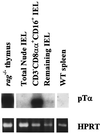Intestinal intraepithelial lymphocytes include precursors committed to the T cell receptor alpha beta lineage
- PMID: 9689102
- PMCID: PMC21360
- DOI: 10.1073/pnas.95.16.9459
Intestinal intraepithelial lymphocytes include precursors committed to the T cell receptor alpha beta lineage
Abstract
The majority of T cells develop in the thymus and exhibit well characterized phenotypic changes associated with their maturation. Previous analysis of intestinal intraepithelial lymphocytes (IEL) from nude mice and a variety of experimentally manipulated models led to the view that at least a portion of these cells represent a distinct T cell population that matures extrathymically. The IEL that are postulated to mature within the intestine include both T cell receptor (TCR) alpha beta- and gamma delta-bearing subpopulations. They can be distinguished from conventional thymically derived T cells in that they express an unusual coreceptor, a CD8alpha homodimer. In addition, they can utilize the Fc receptor gamma-chain in place of the CD3-associated zeta-chain for TCR signaling and their maturation depends on the interleukin 2 receptor beta-chain. Moreover, TCRalpha beta+CD8alpha alpha+ IEL are not subject to conventional thymic selection processes. To determine whether CD3(-)CD8alpha alpha+ IEL represent precursors of T cells developing extrathymically, we examined IEL from knockout mice lacking the recombination activating gene-1 (rag-1), CD3epsilon, or both Lck and Fyn, in which thymic T cell development is arrested. CD3(-)CD8alpha alpha+CD16(+) IEL from all three mutant strains, as well as from nude mice, included cells that express pre-TCRalpha transcripts, a marker of T cell commitment. These IEL from lck-/-fyn-/- animals exhibited TCR beta-gene rearrangement. However, CD3(-)CD8alpha alpha+CD16(+) IEL from epsilon-deficient mice had not undergone Dbeta-Jbeta joining, despite normal rearrangement at the TCRbeta locus in thymocytes from these animals. These results revealed another distinction between thymocytes and IEL, and suggested an unexpectedly early role for CD3epsilon in IEL maturation.
Figures





References
-
- Lefrancois L. J Immunol. 1991;147:1746–1751. - PubMed
Publication types
MeSH terms
Substances
Grants and funding
LinkOut - more resources
Full Text Sources
Miscellaneous

